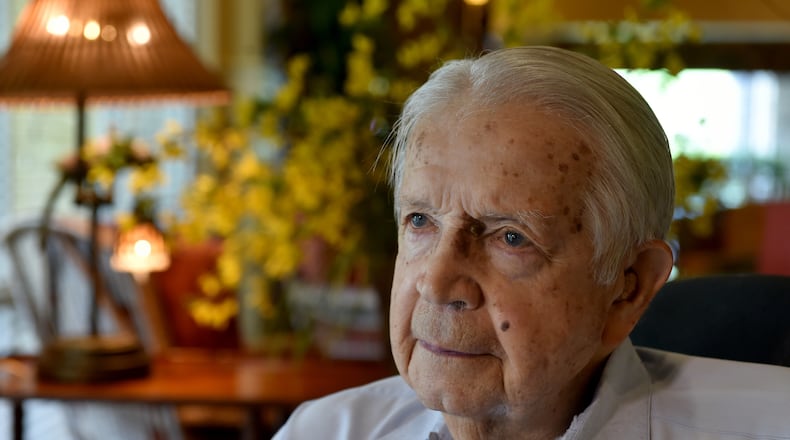JIM STARNES
Age: 94
Residence: Stone Mountain
Service: U.S. Navy, navigator
Jim Starnes has enjoyed a long and happy life, but he still considers Sept. 2, 1945, “the most incredible day of my life.”
That’s the day the longtime Atlanta resident helped organize the surrender of Japan aboard the USS Missouri and greeted the Japanese surrender party as they boarded the ship. After nearly four years of American involvement, the formal occasion sealed the end of World War II – and remains indelibly etched in Starnes’ memory.
“We thought, well, this is going to be a celebration. We’ll get out our swords and polish them up and get in our white uniforms, really make a day of this. But then General (Douglas) MacArthur said no, we fought them in our undressed khaki uniforms and we’ll accept their surrender the same way.”
For Starnes, it was the end of a long and circuitous journey after he enlisted in the Navy as a 19-year-old. Born in Little Rock, Ark., Starnes lived in St. Louis and Des Moines, Iowa, before moving to Atlanta at the age of 9 and graduating from Decatur’s Boys High School. After two years at Emory University, he joined the Navy in June 1940 and went to officers’ training.
“I’m sure there was some patriotism involved, but mainly it was youthful excitement. Join the Navy and see the world.”
That he did, in a short amount of time.
After serving brief stints aboard the USS Illinois and USS Wyoming, he was assigned to the USS Boise in December 1940 as assistant navigator. After a couple of months in Long Beach, Calif., the crew was sent to Pearl Harbor in January 1941 and began making preparations to repel a Japanese attack.
But, he said, everyone was convinced the Japanese would never attack Hawaii.
Starnes trained with the fleet at Pearl Harbor until mid-November when the USS Boise was assigned to take a convoy of merchant ships to China. They arrived in Manila on Dec. 5. Two days later, the Japanese attacked Pearl Harbor.
“It wasn’t until Christmas Eve that some of us had the occasion to go ashore in the East Indies and met some pilots who had flown down from Pearl Harbor. They told us all about the gory details.”
Over the next two-plus years, Starnes made his way around the globe, starting in India and continuing through San Francisco and then back to Pearl Harbor. The Boise’s next mission in July 1942 was to sail to Midway Island and be a decoy to distract the Japanese fleet from the American ships preparing to invade Guadalcanal. Asked how he felt the war effort was going at that point, Starnes didn’t mince words.
“We were getting our ass beat. It was obvious. Guadalcanal was the turning point. Until that point, from Pearl Harbor until 1942, it was very evident that we weren’t winning.”
Starnes was involved in his first major battle in October of that year between Savo Island and Cape Esperance as enemy ships closed in to about 6,000 yards. The Boise’s first belly-to-belly warfare lasted about 15 minutes, and while it had delivered its share of damage, it had been hit by a torpedo on the forward bow and was leaking. The captain made the decision to withdraw from the engagement and try to save the ship. Starnes estimated there were 300 killed or injured on board the Boise.
The ailing ship limped out of the combat zone, through the Panama Canal and on to Philadelphia for repairs.
That’s when Starnes’ European theater experience began. The Boise was sent to the Mediterranean in spring of 1943, where it transported troops and helped prepare for the Allied invasion of Sicily. At that time, Starnes was promoted to navigator. When the invasion was complete, his orders were to report to San Francisco again, which he did aboard a Dutch freighter.
Then he ended up in, of all places, Rhode Island, heading a navigation school for the crews of new ships. He was on a 30-day leave when he heard the details about D-Day in June 1944. Having married a year earlier and having a small child by that point, Starnes was content to ride out the war in Newport.
“I felt like I had done all I could do to fight the war and I was happy to be ashore.”
Not so fast. A date with history awaited him.
His new assignment was as navigator of the USS Missouri, which left New York and arrived in Pearl Harbor on Christmas Eve 1944 to join the Pacific fleet. Having been promoted from lieutenant to lieutenant commander, Starnes’ next trip was to Iwo Jima, then to Okinawa, as the Missouri and its fellow U.S. ships blasted the coast in preparation for an invasion.
Starnes said he had several close calls, such as the time a Japanese kamikaze attack damaged the ship’s stern. Another time, while Starnes was in the navigation quarters, a Japanese shell hit directly below him in the communications quarters, completely destroying it.
After the U.S. dropped the atomic bombs on Hiroshima and Nagasaki in August 1945, the Japanese made preparations to surrender. After opting to hold the ceremony aboard the Missouri, a decision was made to bring an enemy pilot aboard the American ship so he could help the captain avoid minefields in Tokyo Bay. Starnes said the young pilot, who spoke impeccable English, used his cabin overnight.
“I asked him, ‘You think there’s going to be any poor losers who still want to keep fighting?’ And he said, ‘No, when the emperor said it’s over, it’s over.’ … Almost overnight they changed from being a deadly enemy to being a friend. That was a revelation to me of human nature. War is hell, but neighborly love is more powerful.”
The next morning, Starnes was busy prepping for the ceremony and handling the final details as the American commanders came aboard, followed by the Japanese contingent. Everything went exactly as planned. After less than 30 minutes of signatures and salutes, it was all over.
Seventy years later, Starnes recalled it like it was yesterday.
“Indescribable. No. 1, I was here. And No. 2, we had won a war.”
After the war: Starnes enrolled at Emory Law School at night and began building a real estate business. Toward the end of his corporate career, he accepted an assignment as chairman, president and CEO of the real estate subsidiary of North Carolina National Bank, which is now Bank of America.
About the Author
Keep Reading
The Latest
Featured



